sensor MAZDA MODEL 3 4-DOOR 2007 Owner's Manual
[x] Cancel search | Manufacturer: MAZDA, Model Year: 2007, Model line: MODEL 3 4-DOOR, Model: MAZDA MODEL 3 4-DOOR 2007Pages: 402, PDF Size: 5.12 MB
Page 110 of 402
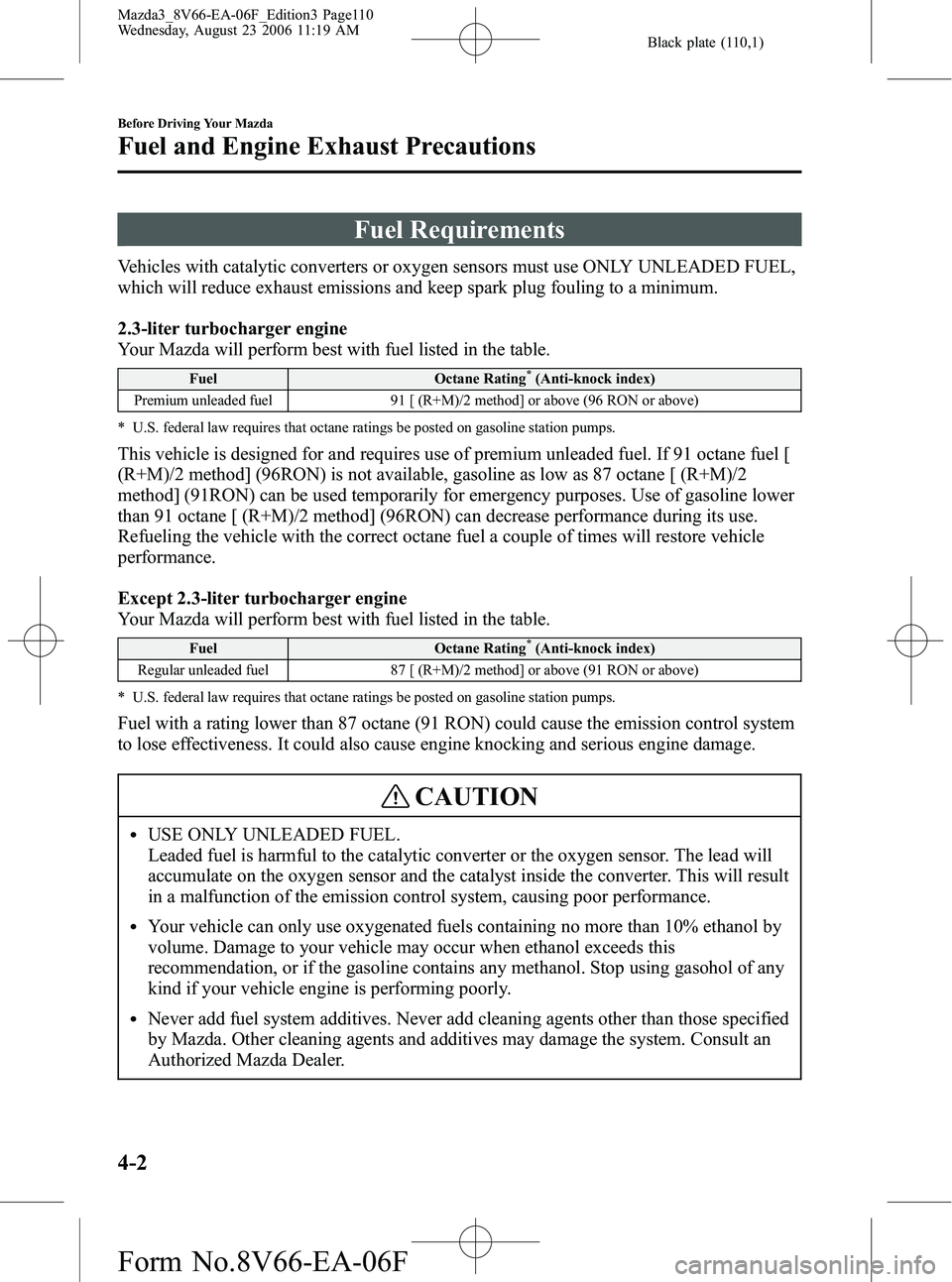
Black plate (110,1)
Fuel Requirements
Vehicles with catalytic converters or oxygen sensors must use ONLY UNLEADED FUEL,
which will reduce exhaust emissions and keep spark plug fouling to a minimum.
2.3-liter turbocharger engine
Your Mazda will perform best with fuel listed in the table.
FuelOctane Rating*(Anti-knock index)
Premium unleaded fuel 91 [ (R+M)/2 method] or above (96 RON or above)
* U.S. federal law requires that octane ratings be posted on gasoline station pumps.
This vehicle is designed for and requires use of premium unleaded fuel. If 91 octane fuel [
(R+M)/2 method] (96RON) is not available, gasoline as low as 87 octane [ (R+M)/2
method] (91RON) can be used temporarily for emergency purposes. Use of gasoline lower
than 91 octane [ (R+M)/2 method] (96RON) can decrease performance during its use.
Refueling the vehicle with the correct octane fuel a couple of times will restore vehicle
performance.
Except 2.3-liter turbocharger engine
Your Mazda will perform best with fuel listed in the table.
Fuel Octane Rating*(Anti-knock index)
Regular unleaded fuel 87 [ (R+M)/2 method] or above (91 RON or above)
* U.S. federal law requires that octane ratings be posted on gasoline station pumps.
Fuel with a rating lower than 87 octane (91 RON) could cause the emission control system
to lose effectiveness. It could also cause engine knocking and serious engine damage.
CAUTION
lUSE ONLY UNLEADED FUEL.
Leaded fuel is harmful to the catalytic converter or the oxygen sensor. The lead will
accumulate on the oxygen sensor and the catalyst inside the converter. This will result
in a malfunction of the emission control system, causing poor performance.
lYour vehicle can only use oxygenated fuels containing no more than 10% ethanol by
volume. Damage to your vehicle may occur when ethanol exceeds this
recommendation, or if the gasoline contains any methanol. Stop using gasohol of any
kind if your vehicle engine is performing poorly.
lNever add fuel system additives. Never add cleaning agents other than those specified
by Mazda. Other cleaning agents and additives may damage the system. Consult an
Authorized Mazda Dealer.
4-2
Before Driving Your Mazda
Fuel and Engine Exhaust Precautions
Mazda3_8V66-EA-06F_Edition3 Page110
Wednesday, August 23 2006 11:19 AM
Form No.8V66-EA-06F
Page 147 of 402
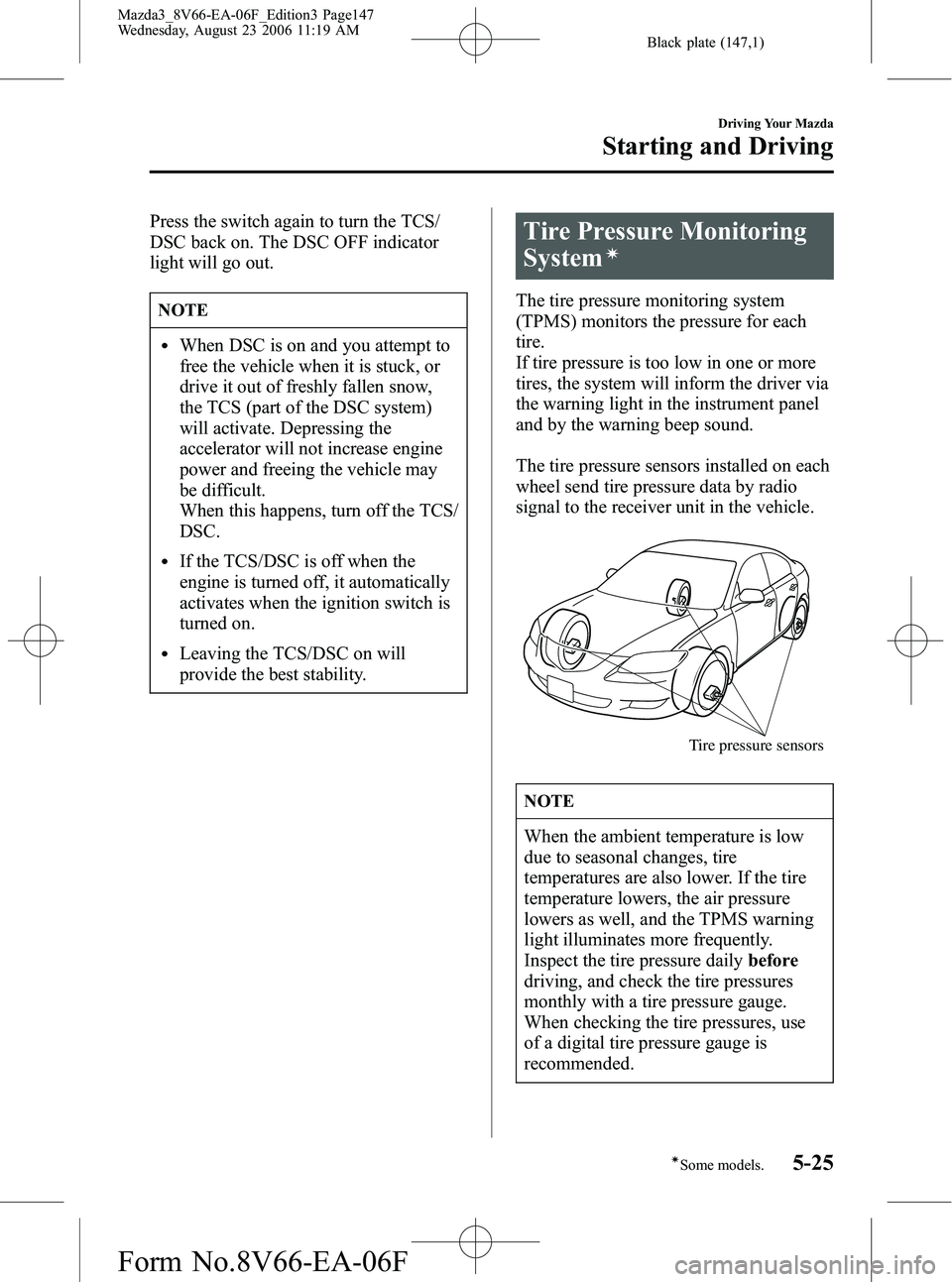
Black plate (147,1)
Press the switch again to turn the TCS/
DSC back on. The DSC OFF indicator
light will go out.
NOTE
lWhen DSC is on and you attempt to
free the vehicle when it is stuck, or
drive it out of freshly fallen snow,
the TCS (part of the DSC system)
will activate. Depressing the
accelerator will not increase engine
power and freeing the vehicle may
be difficult.
When this happens, turn off the TCS/
DSC.
lIf the TCS/DSC is off when the
engine is turned off, it automatically
activates when the ignition switch is
turned on.
lLeaving the TCS/DSC on will
provide the best stability.
Tire Pressure Monitoring
System
í
The tire pressure monitoring system
(TPMS) monitors the pressure for each
tire.
If tire pressure is too low in one or more
tires, the system will inform the driver via
the warning light in the instrument panel
and by the warning beep sound.
The tire pressure sensors installed on each
wheel send tire pressure data by radio
signal to the receiver unit in the vehicle.
Tire pressure sensors
NOTE
When the ambient temperature is low
due to seasonal changes, tire
temperatures are also lower. If the tire
temperature lowers, the air pressure
lowers as well, and the TPMS warning
light illuminates more frequently.
Inspect the tire pressure dailybefore
driving, and check the tire pressures
monthly with a tire pressure gauge.
When checking the tire pressures, use
of a digital tire pressure gauge is
recommended.
Driving Your Mazda
Starting and Driving
5-25íSome models.
Mazda3_8V66-EA-06F_Edition3 Page147
Wednesday, August 23 2006 11:19 AM
Form No.8V66-EA-06F
Page 150 of 402
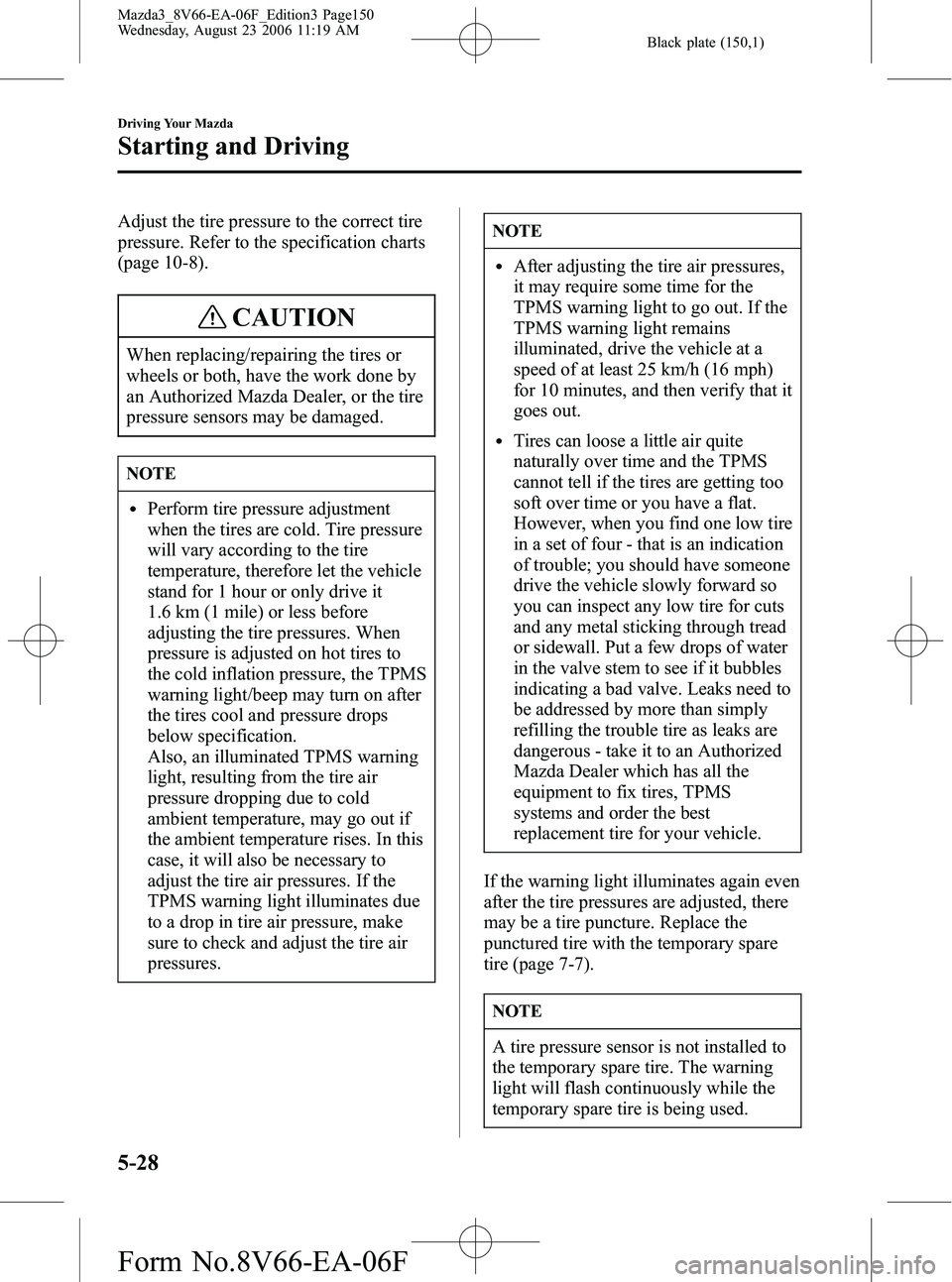
Black plate (150,1)
Adjust the tire pressure to the correct tire
pressure. Refer to the specification charts
(page 10-8).
CAUTION
When replacing/repairing the tires or
wheels or both, have the work done by
an Authorized Mazda Dealer, or the tire
pressure sensors may be damaged.
NOTE
lPerform tire pressure adjustment
when the tires are cold. Tire pressure
will vary according to the tire
temperature, therefore let the vehicle
stand for 1 hour or only drive it
1.6 km (1 mile) or less before
adjusting the tire pressures. When
pressure is adjusted on hot tires to
the cold inflation pressure, the TPMS
warning light/beep may turn on after
the tires cool and pressure drops
below specification.
Also, an illuminated TPMS warning
light, resulting from the tire air
pressure dropping due to cold
ambient temperature, may go out if
the ambient temperature rises. In this
case, it will also be necessary to
adjust the tire air pressures. If the
TPMS warning light illuminates due
to a drop in tire air pressure, make
sure to check and adjust the tire air
pressures.
NOTE
lAfter adjusting the tire air pressures,
it may require some time for the
TPMS warning light to go out. If the
TPMS warning light remains
illuminated, drive the vehicle at a
speed of at least 25 km/h (16 mph)
for 10 minutes, and then verify that it
goes out.
lTires can loose a little air quite
naturally over time and the TPMS
cannot tell if the tires are getting too
soft over time or you have a flat.
However, when you find one low tire
in a set of four - that is an indication
of trouble; you should have someone
drive the vehicle slowly forward so
you can inspect any low tire for cuts
and any metal sticking through tread
or sidewall. Put a few drops of water
in the valve stem to see if it bubbles
indicating a bad valve. Leaks need to
be addressed by more than simply
refilling the trouble tire as leaks are
dangerous - take it to an Authorized
Mazda Dealer which has all the
equipment to fix tires, TPMS
systems and order the best
replacement tire for your vehicle.
If the warning light illuminates again even
after the tire pressures are adjusted, there
may be a tire puncture. Replace the
punctured tire with the temporary spare
tire (page 7-7).
NOTE
A tire pressure sensor is not installed to
the temporary spare tire. The warning
light will flash continuously while the
temporary spare tire is being used.
5-28
Driving Your Mazda
Starting and Driving
Mazda3_8V66-EA-06F_Edition3 Page150
Wednesday, August 23 2006 11:19 AM
Form No.8V66-EA-06F
Page 151 of 402
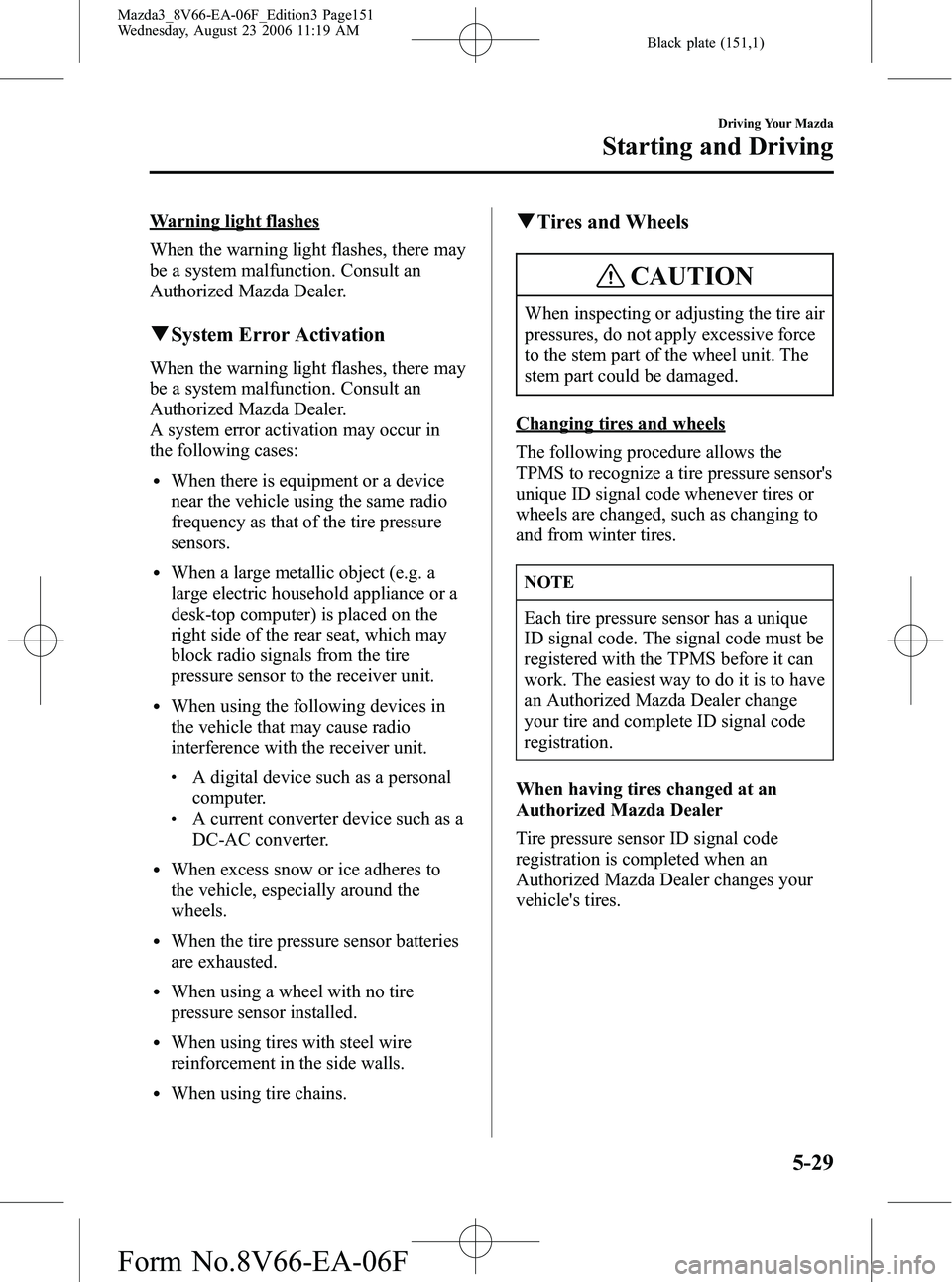
Black plate (151,1)
Warning light flashes
When the warning light flashes, there may
be a system malfunction. Consult an
Authorized Mazda Dealer.
qSystem Error Activation
When the warning light flashes, there may
be a system malfunction. Consult an
Authorized Mazda Dealer.
A system error activation may occur in
the following cases:
lWhen there is equipment or a device
near the vehicle using the same radio
frequency as that of the tire pressure
sensors.
lWhen a large metallic object (e.g. a
large electric household appliance or a
desk-top computer) is placed on the
right side of the rear seat, which may
block radio signals from the tire
pressure sensor to the receiver unit.
lWhen using the following devices in
the vehicle that may cause radio
interference with the receiver unit.
lA digital device such as a personal
computer.
lA current converter device such as a
DC-AC converter.
lWhen excess snow or ice adheres to
the vehicle, especially around the
wheels.
lWhen the tire pressure sensor batteries
are exhausted.
lWhen using a wheel with no tire
pressure sensor installed.
lWhen using tires with steel wire
reinforcement in the side walls.
lWhen using tire chains.
qTires and Wheels
CAUTION
When inspecting or adjusting the tire air
pressures, do not apply excessive force
to the stem part of the wheel unit. The
stem part could be damaged.
Changing tires and wheels
The following procedure allows the
TPMS to recognize a tire pressure sensor's
unique ID signal code whenever tires or
wheels are changed, such as changing to
and from winter tires.
NOTE
Each tire pressure sensor has a unique
ID signal code. The signal code must be
registered with the TPMS before it can
work. The easiest way to do it is to have
an Authorized Mazda Dealer change
your tire and complete ID signal code
registration.
When having tires changed at an
Authorized Mazda Dealer
Tire pressure sensor ID signal code
registration is completed when an
Authorized Mazda Dealer changes your
vehicle's tires.
Driving Your Mazda
Starting and Driving
5-29
Mazda3_8V66-EA-06F_Edition3 Page151
Wednesday, August 23 2006 11:19 AM
Form No.8V66-EA-06F
Page 152 of 402
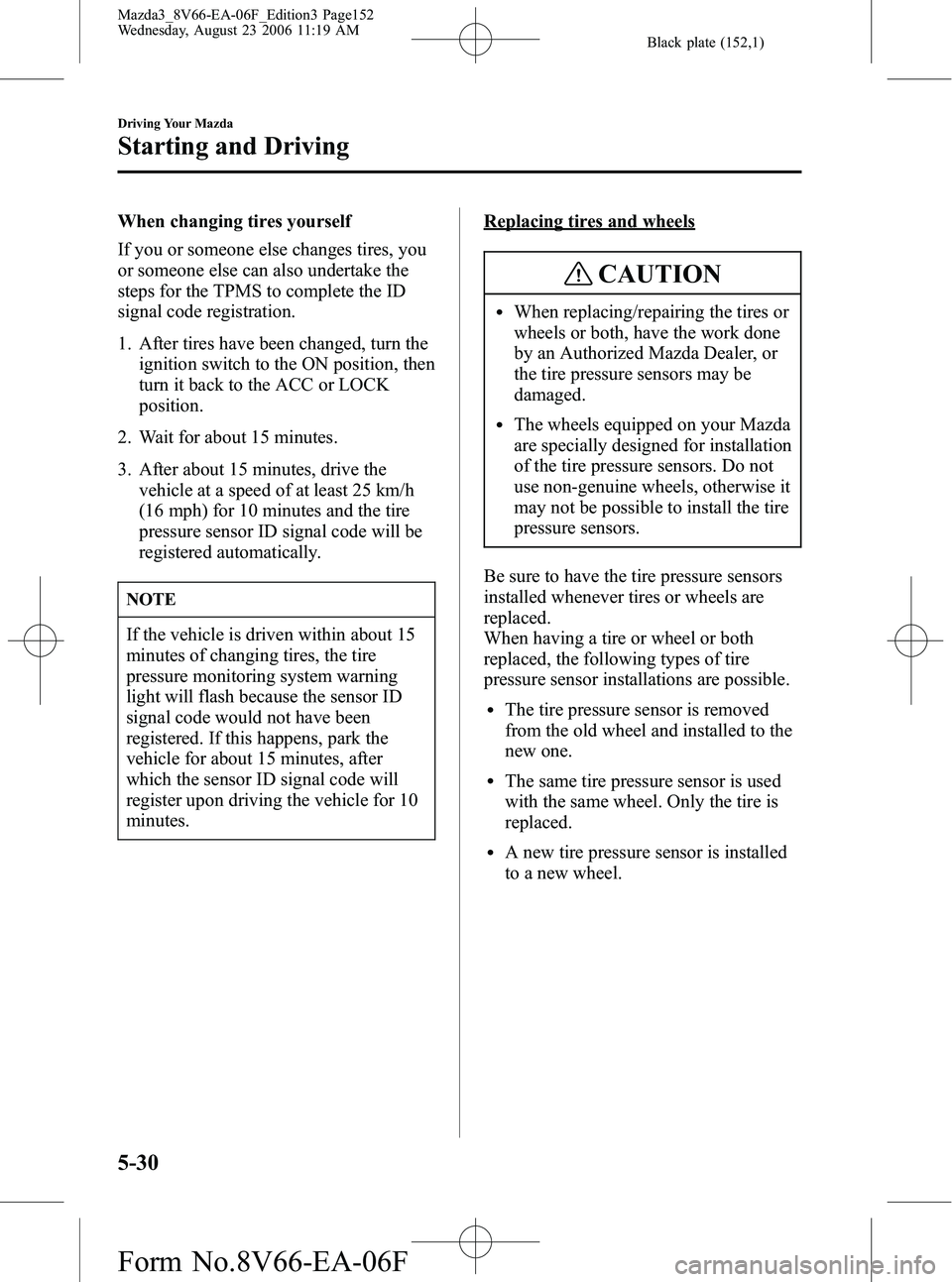
Black plate (152,1)
When changing tires yourself
If you or someone else changes tires, you
or someone else can also undertake the
steps for the TPMS to complete the ID
signal code registration.
1. After tires have been changed, turn theignition switch to the ON position, then
turn it back to the ACC or LOCK
position.
2. Wait for about 15 minutes.
3. After about 15 minutes, drive the vehicle at a speed of at least 25 km/h
(16 mph) for 10 minutes and the tire
pressure sensor ID signal code will be
registered automatically.
NOTE
If the vehicle is driven within about 15
minutes of changing tires, the tire
pressure monitoring system warning
light will flash because the sensor ID
signal code would not have been
registered. If this happens, park the
vehicle for about 15 minutes, after
which the sensor ID signal code will
register upon driving the vehicle for 10
minutes.
Replacing tires and wheels
CAUTION
lWhen replacing/repairing the tires or
wheels or both, have the work done
by an Authorized Mazda Dealer, or
the tire pressure sensors may be
damaged.
lThe wheels equipped on your Mazda
are specially designed for installation
of the tire pressure sensors. Do not
use non-genuine wheels, otherwise it
may not be possible to install the tire
pressure sensors.
Be sure to have the tire pressure sensors
installed whenever tires or wheels are
replaced.
When having a tire or wheel or both
replaced, the following types of tire
pressure sensor installations are possible.
lThe tire pressure sensor is removed
from the old wheel and installed to the
new one.
lThe same tire pressure sensor is used
with the same wheel. Only the tire is
replaced.
lA new tire pressure sensor is installed
to a new wheel.
5-30
Driving Your Mazda
Starting and Driving
Mazda3_8V66-EA-06F_Edition3 Page152
Wednesday, August 23 2006 11:19 AM
Form No.8V66-EA-06F
Page 153 of 402
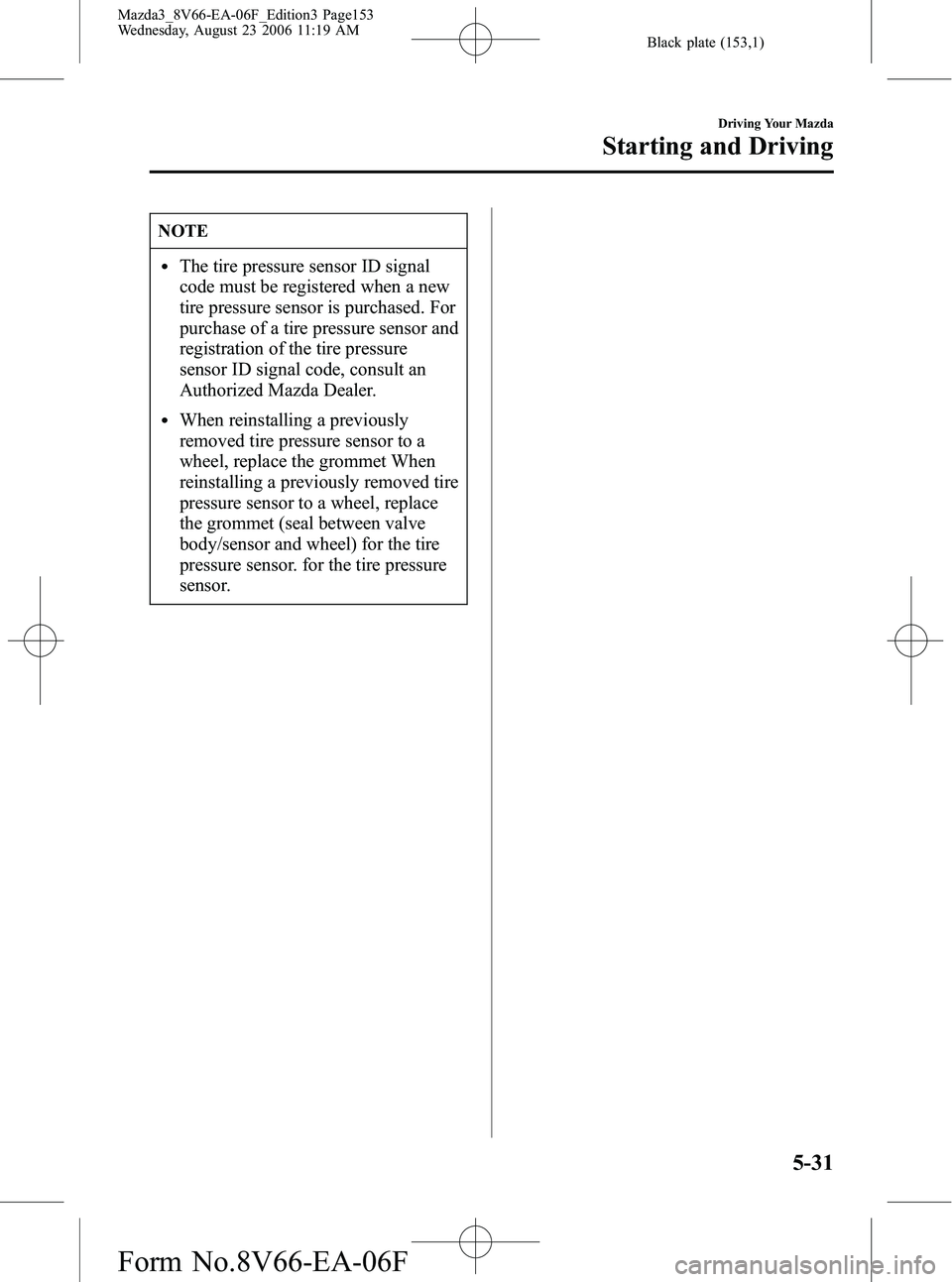
Black plate (153,1)
NOTE
lThe tire pressure sensor ID signal
code must be registered when a new
tire pressure sensor is purchased. For
purchase of a tire pressure sensor and
registration of the tire pressure
sensor ID signal code, consult an
Authorized Mazda Dealer.
lWhen reinstalling a previously
removed tire pressure sensor to a
wheel, replace the grommet When
reinstalling a previously removed tire
pressure sensor to a wheel, replace
the grommet (seal between valve
body/sensor and wheel) for the tire
pressure sensor. for the tire pressure
sensor.
Driving Your Mazda
Starting and Driving
5-31
Mazda3_8V66-EA-06F_Edition3 Page153
Wednesday, August 23 2006 11:19 AM
Form No.8V66-EA-06F
Page 165 of 402
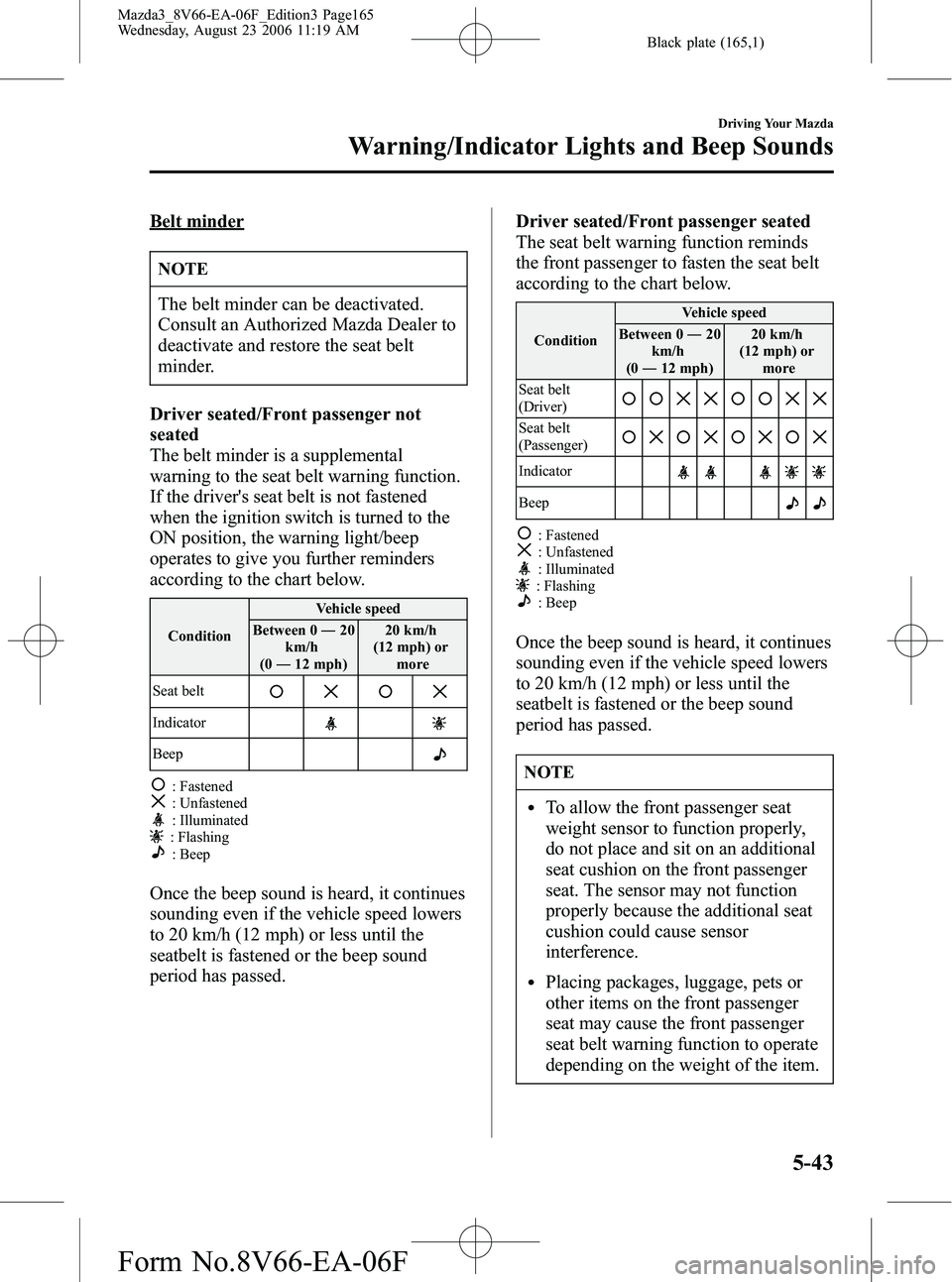
Black plate (165,1)
Belt minder
NOTE
The belt minder can be deactivated.
Consult an Authorized Mazda Dealer to
deactivate and restore the seat belt
minder.
Driver seated/Front passenger not
seated
The belt minder is a supplemental
warning to the seat belt warning function.
If the driver's seat belt is not fastened
when the ignition switch is turned to the
ON position, the warning light/beep
operates to give you further reminders
according to the chart below.
Condition Vehicle speed
Between 0 ―20
km/h
(0 ― 12 mph) 20 km/h
(12 mph) or more
Seat belt
Indicator
Beep
: Fastened: Unfastened: Illuminated: Flashing: Beep
Once the beep sound is heard, it continues
sounding even if the vehicle speed lowers
to 20 km/h (12 mph) or less until the
seatbelt is fastened or the beep sound
period has passed. Driver seated/Front passenger seated
The seat belt warning function reminds
the front passenger to fasten the seat belt
according to the chart below.
Condition
Vehicle speed
Between 0 ―20
km/h
(0 ― 12 mph) 20 km/h
(12 mph) or more
Seat belt
(Driver)
Seat belt
(Passenger)
Indicator
Beep
: Fastened: Unfastened: Illuminated: Flashing: Beep
Once the beep sound is heard, it continues
sounding even if the vehicle speed lowers
to 20 km/h (12 mph) or less until the
seatbelt is fastened or the beep sound
period has passed.
NOTE
lTo allow the front passenger seat
weight sensor to function properly,
do not place and sit on an additional
seat cushion on the front passenger
seat. The sensor may not function
properly because the additional seat
cushion could cause sensor
interference.
lPlacing packages, luggage, pets or
other items on the front passenger
seat may cause the front passenger
seat belt warning function to operate
depending on the weight of the item.
Driving Your Mazda
Warning/Indicator Lights and Beep Sounds
5-43
Mazda3_8V66-EA-06F_Edition3 Page165
Wednesday, August 23 2006 11:19 AM
Form No.8V66-EA-06F
Page 167 of 402
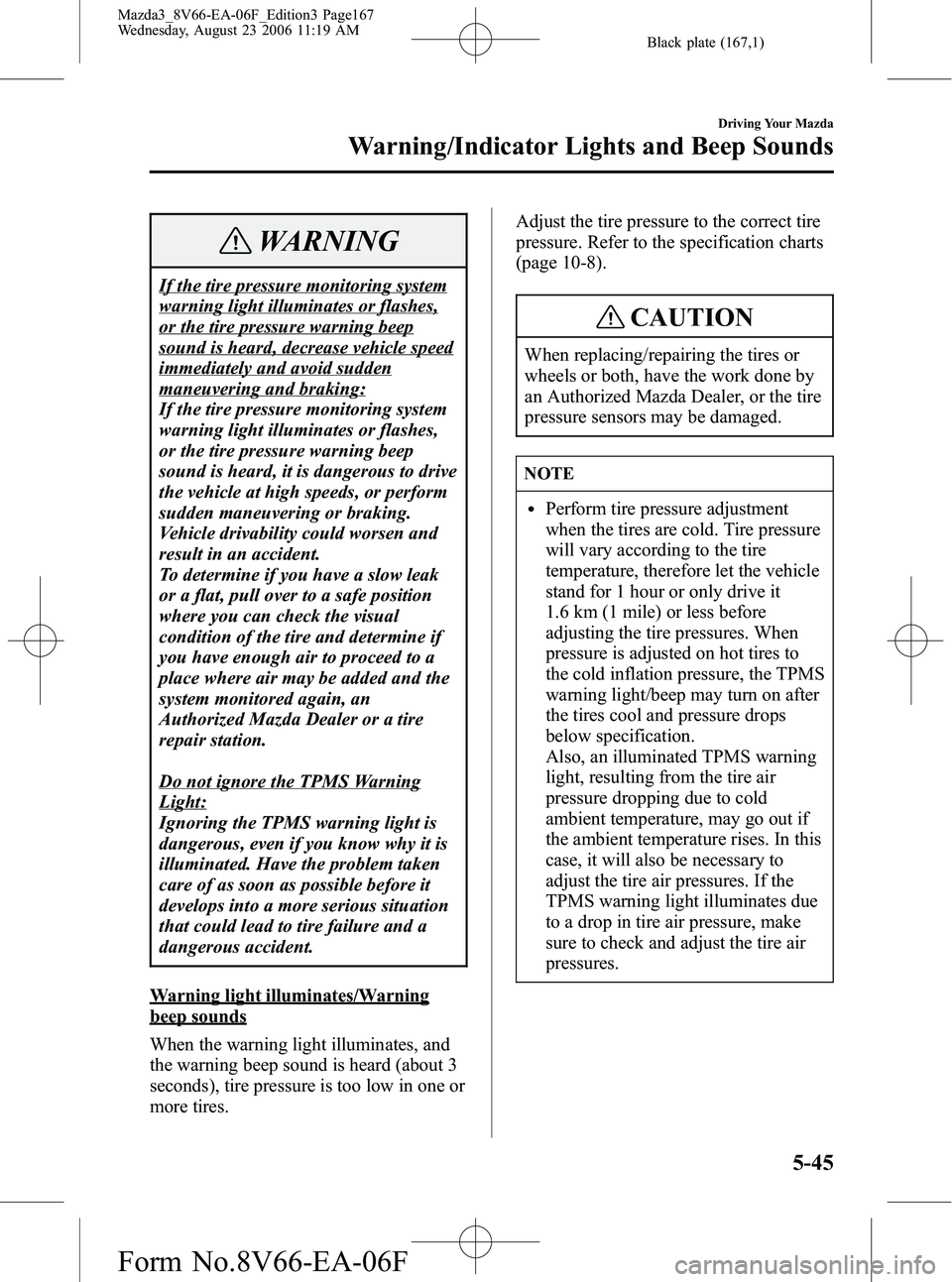
Black plate (167,1)
WARNING
If the tire pressure monitoring system
warning light illuminates or flashes,
or the tire pressure warning beep
sound is heard, decrease vehicle speed
immediately and avoid sudden
maneuvering and braking:
If the tire pressure monitoring system
warning light illuminates or flashes,
or the tire pressure warning beep
sound is heard, it is dangerous to drive
the vehicle at high speeds, or perform
sudden maneuvering or braking.
Vehicle drivability could worsen and
result in an accident.
To determine if you have a slow leak
or a flat, pull over to a safe position
where you can check the visual
condition of the tire and determine if
you have enough air to proceed to a
place where air may be added and the
system monitored again, an
Authorized Mazda Dealer or a tire
repair station.
Do not ignore the TPMS Warning
Light:
Ignoring the TPMS warning light is
dangerous, even if you know why it is
illuminated. Have the problem taken
care of as soon as possible before it
develops into a more serious situation
that could lead to tire failure and a
dangerous accident.
Warning light illuminates/Warning
beep sounds
When the warning light illuminates, and
the warning beep sound is heard (about 3
seconds), tire pressure is too low in one or
more tires.Adjust the tire pressure to the correct tire
pressure. Refer to the specification charts
(page 10-8).
CAUTION
When replacing/repairing the tires or
wheels or both, have the work done by
an Authorized Mazda Dealer, or the tire
pressure sensors may be damaged.
NOTE
lPerform tire pressure adjustment
when the tires are cold. Tire pressure
will vary according to the tire
temperature, therefore let the vehicle
stand for 1 hour or only drive it
1.6 km (1 mile) or less before
adjusting the tire pressures. When
pressure is adjusted on hot tires to
the cold inflation pressure, the TPMS
warning light/beep may turn on after
the tires cool and pressure drops
below specification.
Also, an illuminated TPMS warning
light, resulting from the tire air
pressure dropping due to cold
ambient temperature, may go out if
the ambient temperature rises. In this
case, it will also be necessary to
adjust the tire air pressures. If the
TPMS warning light illuminates due
to a drop in tire air pressure, make
sure to check and adjust the tire air
pressures.
Driving Your Mazda
Warning/Indicator Lights and Beep Sounds
5-45
Mazda3_8V66-EA-06F_Edition3 Page167
Wednesday, August 23 2006 11:19 AM
Form No.8V66-EA-06F
Page 168 of 402
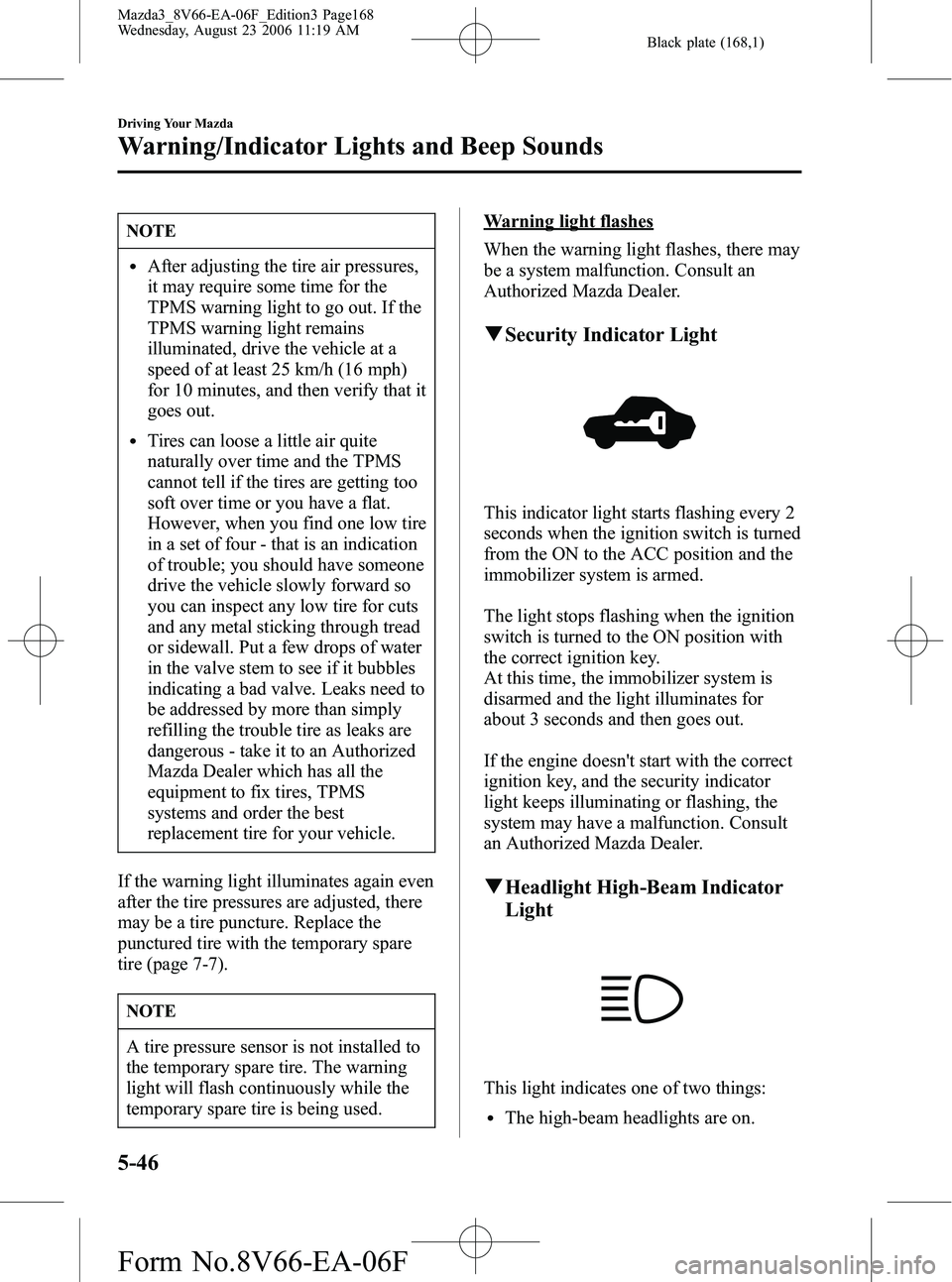
Black plate (168,1)
NOTE
lAfter adjusting the tire air pressures,
it may require some time for the
TPMS warning light to go out. If the
TPMS warning light remains
illuminated, drive the vehicle at a
speed of at least 25 km/h (16 mph)
for 10 minutes, and then verify that it
goes out.
lTires can loose a little air quite
naturally over time and the TPMS
cannot tell if the tires are getting too
soft over time or you have a flat.
However, when you find one low tire
in a set of four - that is an indication
of trouble; you should have someone
drive the vehicle slowly forward so
you can inspect any low tire for cuts
and any metal sticking through tread
or sidewall. Put a few drops of water
in the valve stem to see if it bubbles
indicating a bad valve. Leaks need to
be addressed by more than simply
refilling the trouble tire as leaks are
dangerous - take it to an Authorized
Mazda Dealer which has all the
equipment to fix tires, TPMS
systems and order the best
replacement tire for your vehicle.
If the warning light illuminates again even
after the tire pressures are adjusted, there
may be a tire puncture. Replace the
punctured tire with the temporary spare
tire (page 7-7).
NOTE
A tire pressure sensor is not installed to
the temporary spare tire. The warning
light will flash continuously while the
temporary spare tire is being used.
Warning light flashes
When the warning light flashes, there may
be a system malfunction. Consult an
Authorized Mazda Dealer.
q Security Indicator Light
This indicator light starts flashing every 2
seconds when the ignition switch is turned
from the ON to the ACC position and the
immobilizer system is armed.
The light stops flashing when the ignition
switch is turned to the ON position with
the correct ignition key.
At this time, the immobilizer system is
disarmed and the light illuminates for
about 3 seconds and then goes out.
If the engine doesn't start with the correct
ignition key, and the security indicator
light keeps illuminating or flashing, the
system may have a malfunction. Consult
an Authorized Mazda Dealer.
qHeadlight High-Beam Indicator
Light
This light indicates one of two things:
lThe high-beam headlights are on.
5-46
Driving Your Mazda
Warning/Indicator Lights and Beep Sounds
Mazda3_8V66-EA-06F_Edition3 Page168
Wednesday, August 23 2006 11:19 AM
Form No.8V66-EA-06F
Page 173 of 402

Black plate (173,1)
Lighting Control
qHeadlights
Type A (Without AUTO position)
Turn the headlight switch to turn the
headlights, other exterior lights and
dashboard illumination on or off.
Switch Position
Headlights Off Off On
Taillights
Parking lights
License lights
Side-marker lights
Dashboard illumination Off On On
NOTE
To prevent discharging the battery, don't
leave the lights on while the engine is
off unless safety requires them.
Type B (With AUTO position)
Turn the headlight switch to turn the
headlights, other exterior lights and
dashboard illumination on or off.
Switch Position
Headlights Off Off On
Auto
Taillights
Parking lights
License lights
Side-marker
lights
Dashboard
illumination Off On On
NOTE
To prevent discharging the battery, don't
leave the lights on while the engine is
off unless safety requires them.
AUTO(Auto-light control)
When the headlight switch is in the
AUTO position and the ignition switch is
in the ON position, the light sensor senses
the surrounding lightness or darkness and
automatically turns on or off the
headlights, other exterior lights and
dashboard illumination (see chart above).
Driving Your Mazda
Switches and Controls
5-51
Mazda3_8V66-EA-06F_Edition3 Page173
Wednesday, August 23 2006 11:19 AM
Form No.8V66-EA-06F